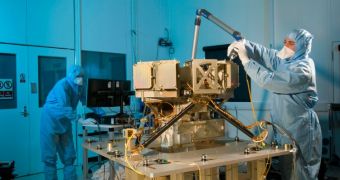Since NASA is collaborating with the European Space Agency on its next-generation James Webb Space Telescope, the latter contributes several components to the observatory, including the Min InfraRed Instrument. The device has been handed to ESA, and is now ready for delivery to the US.
MIRI was developed by a consortium of European companies, which delivered it to ESA officials during a ceremony held in London, the United Kingdom, on May 9. The instrument will fly to space aboard the JWST when the massive telescope launches, no earlier than 2018.
The successful completion of MIRI marks an important achievement for the entire JWST project. Over the past few months, all contractors and subcontractors working on various components for the observatory have reached their respective milestones successfully.
As a side-note, the development of the telescope has been hampered by poor management since its inception. A couple of years ago, NASA and Congress cleaned house in the upper tiers of mission managers, setting the project back on course. The drawback is an $8.8 billion price tag.
When it finally launches, the JWST will be the most advanced satellite ever deployed to space, exceeding ESA's Herschel Space Observatory in terms of size, complexity and capabilities. Herschel is now the most advanced infrared telescope ever flown.
During the ceremony held today, ESA officials were presented with the results of rigorous testing and calibrations that MIRI underwent after actual construction efforts concluded. The consortium that made the instrument says that it can handle the most complex scientific tasks.
“The whole team is delighted that our hard work and dedication has resulted in a MIRI instrument that will meet all our scientific expectations,” explains the ESA MIRI principal investigator, Dr. Gillian Wright. The main components of the instrument are a camera and a spectrometer.
“It is wonderful to be the first to achieve this major milestone for the JWST project. We can now look forward to significant scientific discoveries when it is launched,” she goes on to say.
One of the most severe specifications that the consortium needed to stick by was to make MIRI capable of conducting accurate observations at temperatures of minus 266 degrees Celsius (-446.8ºF), just 7ºC above absolute zero.
“It is an immensely challenging project, but together with our US and Canadian colleagues, European scientists and engineers have successfully risen to the challenge and are now delivering key parts of JWST to NASA,” says the Head of the ESA Research and Scientific Support Department, professor Mark McCaughrean.

 14 DAY TRIAL //
14 DAY TRIAL //